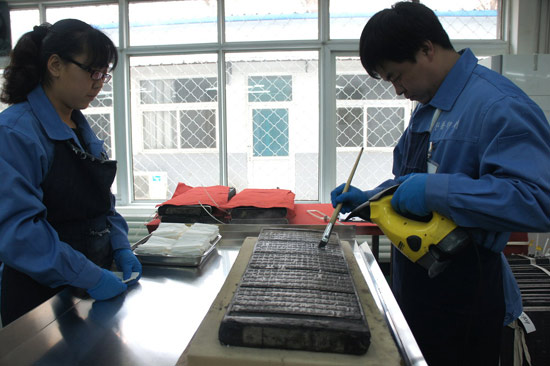Efforts to conserve cultural heritage
Updated: 2012-02-29 17:24
By Zhu Linyong (China Daily)
|
|||||||||||
 |
|
Conservationists are cleaning buddhist canon woodblocks at studio in Daxing, southern Beijing. [Photo/China Daily] |
BEIJING — The Capital Museum and Bank of America Merrill Lynch launched a major joint project in Beijing to rescue a rare set of Buddhist canon woodblocks. The museum will receive conservation funding on the cleaning of the Qianlong Great Buddhist Canon Carved Woodblocks through the bank’s global Art Conservation Project, said the museum’s director, Guo Xiaoling.
The cleaning project kicked off in January and is expected to run for at least 200 days. The Qianlong Great Buddhist Canon, also known as Tripitaka or Dragon Tripitaka in short, “is a treasure to China and the world’s Buddhist community and is of extraordinary significance in history, literature and art,” said Guo.
The Qianlong Great Buddhist Canon, composed of 724 cases and totaling 7,240 volumes, is a complete collection of 1,669 Buddhist sutras, teachings, treatises and other literary content.
Believed to be the last official Tripitaka and the only existing one in China, it was carved on 79,036 woodblocks during the reign of Emperor Yongzheng in the Qing Dynasty in 1733 and completed during the reign of Emperor Qianlong in the Qing Dynasty in 1738.
However, due to social and historical reasons and natural degeneration, more than 20 percent of the 69,410 carved woodblocks have deteriorated and are in urgent need of conservation, said Hu Dongbo, a Peking University professor specializing in cultural heritage conservation and a key expert for the Buddhist canon woodblocks cleaning project.
Each case has 10 volumes.
The Tripitaka woodblocks conserved at the Capital Museum are the final edition of the Buddhist sutra in China as well as the only set of carved woodblocks for Tripitaka in Chinese still kept in China. The book contains not only the Buddhist sutras, but also collects the works, remarks, biographies, catalogues and other content about eminent monks in the Yuan Dynasty, the Ming Dynasty and the Qing Dynasty. The book covers a broad range of areas including politics, economics, culture, astronomy, geography and daily life, and is of extraordinary significance in history, literature and art, say experts.
The Capital Museum has invited a group of experts to draw a blueprint for the protection and conservation of the Buddhist canon.
The funding from the bank, the actual amount of which was not disclosed by the two sides, is enough to support the cleaning of 5,000 pieces of Qianlong Great Buddhist Canon Carved Woodblocks.
But “a comprehensive conservation of the whole Buddhist canon, including cleaning, correcting erroneous characters and restoring the missing characters on the woodblocks may take eight to 10 years, said He Weiliang, a chief expert in charge of the cleaning work. The Bank of America Merrill Lynch Art Conservation Project supports the arts worldwide through sponsorships, grants and loans, said the bank’s Asia-Pacific president Brian J. Brille.
“It is a good and innovative trial to diversify the source of funding to protect the Qianlong Great Buddhist Canon,” said Guo Xiaoling. “We hope that corporate involvement will play an instrumental role in grand-scale cultural relic conservation projects in the future.”